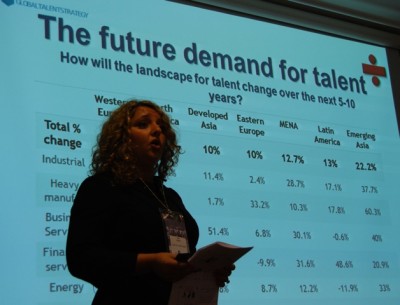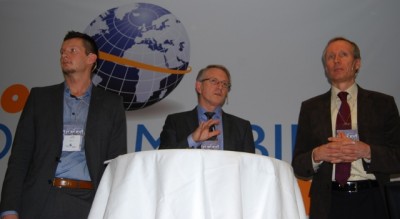Norway has nice scenery and has become more attractive to talented foreign workers amidst ever-growing global mobility, but can and should do much more to make the country more accessible to those it needs. That was the general consensus of experts at the second Global Mobility Forum held in Oslo on Thursday.

“Norway is actually an attractive country for talent,” said Sally Khallash, founder of the Centre for Global Talent Strategy in Oxford. It ranked highest in a recent study of how attractive Scandinavian countries are to migrant labour with special talent, but Khallash noted that it ranked much lower in terms of accessibility.
The key issue, she stressed, is “how do we make it easier for people to come” to Scandinavia, where Norway, for example, currently lacks 16,000 engineers and a new Manpower study also cites an even bigger lack of salespeople. It was an issue that came up repeatedly at the conference that attracted hundreds to the headquarters of Norway’s main employers’ organization NHO.
Despite large increases in the numbers of first-time work permits being granted to foreigners in Norway, and a steady stream of talented and eager workers arriving in Norway from crisis-hit countries elsewhere in Europe, there are signs that Norway is losing talent and high-end jobs to competing cites viewed as far more internationally oriented. The world’s biggest rig company, Seadrill, recently confirmed plans to move its headquarters from Stavanger and is eyeing other cities including London and Dubai. Conference organizer Bjørn Nørbech of Kulturtolk in Oslo, which helps companies deal with and profit from global mobility, noted that Aker Solutions attended last year’s event to recruit staff but this year it’s recruiting in London.

“It’s easier to attract global talent there,” Nørbech said, with Khallash stressing that “location still matters.” It’s simply harder for cities like Oslo, Stavanger or Hammerfest to attract the workers London can. Norwegian firms benefiting from Norway’s strong economy thus face tough competition finding the workers they need, agreed conference co-host Paul Chaffey, a former Norwegian politician for the Socialist Left party (SV) who now heads Abelia, NHO’s organization for knowledge- and technology-based firms.
“In the old days, there was never really a question of how to get people to fill jobs, it was the other way around,” Chaffey said. Now Norway needs to attract foreign labour and, as Khallash said, make it easier to move to Norway and stick around.

On hand to confront concerns about what many view as Norway’s still-protected labour market were top officials from the country’s Labour Ministry, immigration agency UDI (Utlendingsdirektoratet) and NOKUT, the Norwegian Agency for Quality Assurance in Education. NOKUT, for example, is charged with verifying the educational credentials of foreigners in Norway, and the process (mandatory for 170 various professions in Norway) can take many months.
It can also take a long time for foreigners to receive the work permits, tax cards, ID numbers and other bureaucratic authorization they need to move to Norway, especially if coming from outside the European Economic Area. New UDI director Frode Forfang said he’s noted, though, that despite the controversy immigration still stirs in Norway, he’s seen “quite a big change” and that labour immigration is now viewed positively.
‘Facilitators’
Both Forfang and Gina Lund, state secretary in the Labour Ministry, claimed it’s become easier to move to Norway: Foreign students can now stay six months upon completion of their degrees to find work in Norway instead of having to immediately take their higher education home with them, new Foreign Worker Centers have been set up in Oslo, Stavanger and Kirkenes to streamline the process, and processing time, although still too high, has been reduced. UDI has changed the way it works, Forfang claimed, saying that “we see ourselves as facilitators,” not strictly as those charged with controlling immigration.
Lund pointed to statistics in the state budget showing that 70 percent of new jobs created in Norway go to immigrants, shoring up suggestions Norway is attractive. “We’re proud of our welfare system, our family and equality policies, and they’re attractive to foreign workers,” Lund claimed, insisting, though, that the government also needs “to mobilize our own work force,” both Norwegians and immigrants already in Norway. Many policies still protect Norwegian workers from foreign competition, although Lund contended the government has made it easier for Norwegian companies to hire from abroad.
Dissatisfaction
Not everyone in the audience agreed, with some saying it still takes far too long to get workers and not least their families into the country, and the process is too cumbersome. It must be streamlined further, to better accommodate employers’ needs, several claimed, and communication among the agencies and with employers must improve.
“We’re working on it,” Forfang insisted, while admitting his agency is bound by the politics of the government in power. Arvid Hallén, director of the Research Council of Norway which he said faces “challenges” itself in attracting and retaining international researchers, thinks the problem lies more with “motivation” of state workers than with a chronic lack of resources and staffing. “I want as low a fence as possible,” he said.
Views and News from Norway/Nina Berglund
Please support our news service. Readers in Norway can use our donor account. Our international readers can click on our “Donate” button:

